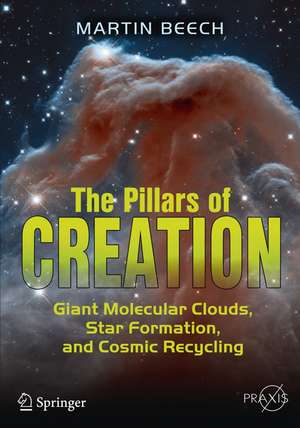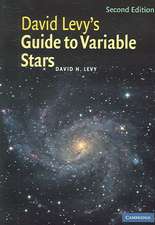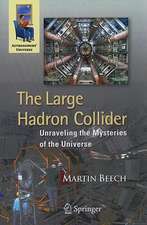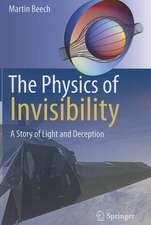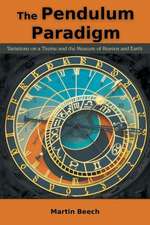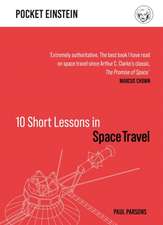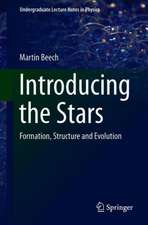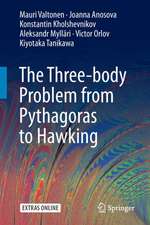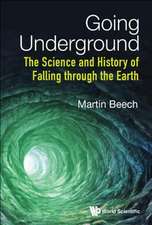The Pillars of Creation: Giant Molecular Clouds, Star Formation, and Cosmic Recycling: Springer Praxis Books
Autor Martin Beechen Limba Engleză Paperback – 6 ian 2017
Although the Big Bang provided the spark of initiation, the primordial universe that it sired was born hopelessly sterile. It is only through the continued recycling of the interstellar medium, star formation, and stellar evolution that the universe has been animated beyond a chaotic mess of elementary atomic particles, radiation, dark matter, dark energy, and expanding spacetime. Using the Milky Way and the Eagle Nebula in particular as case studies, Beech follows every step of this amazing process.
Din seria Springer Praxis Books
-
 Preț: 294.46 lei
Preț: 294.46 lei -
 Preț: 223.45 lei
Preț: 223.45 lei -
 Preț: 193.12 lei
Preț: 193.12 lei -
 Preț: 167.85 lei
Preț: 167.85 lei -
 Preț: 288.98 lei
Preț: 288.98 lei -
 Preț: 323.74 lei
Preț: 323.74 lei -
 Preț: 401.38 lei
Preț: 401.38 lei -
 Preț: 264.12 lei
Preț: 264.12 lei - 8%
 Preț: 513.00 lei
Preț: 513.00 lei -
 Preț: 190.01 lei
Preț: 190.01 lei -
 Preț: 218.16 lei
Preț: 218.16 lei -
 Preț: 312.06 lei
Preț: 312.06 lei - 17%
 Preț: 414.05 lei
Preț: 414.05 lei -
 Preț: 216.41 lei
Preț: 216.41 lei -
 Preț: 262.27 lei
Preț: 262.27 lei -
 Preț: 264.35 lei
Preț: 264.35 lei -
 Preț: 167.63 lei
Preț: 167.63 lei -
 Preț: 284.81 lei
Preț: 284.81 lei -
 Preț: 259.08 lei
Preț: 259.08 lei -
 Preț: 305.47 lei
Preț: 305.47 lei -
 Preț: 244.14 lei
Preț: 244.14 lei -
 Preț: 227.85 lei
Preț: 227.85 lei -
 Preț: 285.25 lei
Preț: 285.25 lei -
 Preț: 295.56 lei
Preț: 295.56 lei -
 Preț: 357.17 lei
Preț: 357.17 lei -
 Preț: 275.79 lei
Preț: 275.79 lei -
 Preț: 257.08 lei
Preț: 257.08 lei -
 Preț: 349.71 lei
Preț: 349.71 lei -
 Preț: 272.45 lei
Preț: 272.45 lei -
 Preț: 270.27 lei
Preț: 270.27 lei - 8%
 Preț: 456.51 lei
Preț: 456.51 lei -
 Preț: 352.34 lei
Preț: 352.34 lei - 8%
 Preț: 394.80 lei
Preț: 394.80 lei -
 Preț: 320.65 lei
Preț: 320.65 lei -
 Preț: 325.29 lei
Preț: 325.29 lei -
 Preț: 253.11 lei
Preț: 253.11 lei -
 Preț: 192.86 lei
Preț: 192.86 lei -
 Preț: 313.40 lei
Preț: 313.40 lei -
 Preț: 150.51 lei
Preț: 150.51 lei -
 Preț: 233.34 lei
Preț: 233.34 lei -
 Preț: 286.78 lei
Preț: 286.78 lei -
 Preț: 212.01 lei
Preț: 212.01 lei -
 Preț: 366.83 lei
Preț: 366.83 lei -
 Preț: 299.99 lei
Preț: 299.99 lei -
 Preț: 232.27 lei
Preț: 232.27 lei -
 Preț: 284.58 lei
Preț: 284.58 lei -
 Preț: 212.45 lei
Preț: 212.45 lei -
 Preț: 159.81 lei
Preț: 159.81 lei -
 Preț: 349.48 lei
Preț: 349.48 lei - 20%
 Preț: 2061.64 lei
Preț: 2061.64 lei
Preț: 275.30 lei
Nou
Puncte Express: 413
Preț estimativ în valută:
52.68€ • 55.00$ • 43.50£
52.68€ • 55.00$ • 43.50£
Carte tipărită la comandă
Livrare economică 11-17 aprilie
Preluare comenzi: 021 569.72.76
Specificații
ISBN-13: 9783319487748
ISBN-10: 3319487744
Pagini: 280
Ilustrații: XII, 269 p. 125 illus., 109 illus. in color.
Dimensiuni: 168 x 240 x 18 mm
Greutate: 0.41 kg
Ediția:1st ed. 2017
Editura: Springer International Publishing
Colecția Springer
Seriile Springer Praxis Books, Popular Astronomy
Locul publicării:Cham, Switzerland
ISBN-10: 3319487744
Pagini: 280
Ilustrații: XII, 269 p. 125 illus., 109 illus. in color.
Dimensiuni: 168 x 240 x 18 mm
Greutate: 0.41 kg
Ediția:1st ed. 2017
Editura: Springer International Publishing
Colecția Springer
Seriile Springer Praxis Books, Popular Astronomy
Locul publicării:Cham, Switzerland
Cuprins
Preface.- Chapter 1- Reading the Sky.- Chapter 2 - In the Eye of the Beholder.- Chapter 3: The Dark Clouds Revealed.- Chapter 4 – The Hyperfine Split and Atomic Jitters.- Chapter 5 – In the Grip of Gravity.- Chapter 6 - It's a Far Flung Life.- Appendix - Notes and References.- Index.
Recenzii
“The Pillars of Creation is an excellent mix of the history of astronomy and physics together with modern astronomy and chemistry without too many difficult terms or equations … . Reading this book was an enjoyable experience, as various angles on the same topic or same astronomical object were presented … . All in all though, it's an excellent account of how molecular clouds form, how stars are born and how they end their lives … .” (AstroMadness.com, October 30, 2019)
Notă biografică
Martin Beech is a Professor and Department Head of Astronomy at Campion College, The University of Regina, Canada. He has an MSc from Sussex, UK, and earned his PhD at Western Ontario. He has written several books for Springer, most recently "Alpha Centauri: Unveiling the Secrets of Our Nearest Stellar Neighbor" (2015).
Textul de pe ultima copertă
This book explores the mechanics of star formation, the process by which matter pulls together and creates new structures. Written for science enthusiasts, the author presents an accessible explanation of how stars are born from the interstellar medium and giant molecular clouds. Stars produce the chemicals that lead to life, and it is they that have enabled the conditions for planets to form and life to emerge.
Although the Big Bang provided the spark of initiation, the primordial universe that it sired was born hopelessly sterile. It is only through the continued recycling of the interstellar medium, star formation, and stellar evolution that the universe has been animated beyond a chaotic mess of elementary atomic particles, radiation, dark matter, dark energy, and expanding spacetime. Using the Milky Way and the Eagle Nebula in particular as case studies, Beech follows every step of this amazing process.
Although the Big Bang provided the spark of initiation, the primordial universe that it sired was born hopelessly sterile. It is only through the continued recycling of the interstellar medium, star formation, and stellar evolution that the universe has been animated beyond a chaotic mess of elementary atomic particles, radiation, dark matter, dark energy, and expanding spacetime. Using the Milky Way and the Eagle Nebula in particular as case studies, Beech follows every step of this amazing process.
Caracteristici
Explains each step of how stars are formed within molecular clouds in the interstellar medium Illuminates the key role of molecular clouds in the existence of life on Earth Covers the full sweep of the Universe's evolution, from the Big Bang to the later production of organic chemicals in stars Uses non-technical language suitable for non-scientists
